Ahhh-Churaevka! Gesundheit!
Russian Village, Southbury
April 2, 2011
I should be used to this by now. Finding out about something mildly interesting in Connecticut, going there, and learning it’s ten times cooler than I’d ever thought it would be. In the case of Churaevka, once I read up on the place after visiting, I realized it’s actually a full fifty-seven times cooler than I originally thought.

Now, I’m going to take the lazy way out of this page and simply copy/paste/excerpt the story of this place from another source. I rarely do this, but in this case it just seems to make sense. But before I do, I’ll tell my personal experience over at Churaevka. I came across a blurb about it a couple years ago and filed it away, never really giving it much thought. So when I put together an afternoon’s itinerary of random stuff to do with Damian, I looked on a map where this Russian Village was (right off the highway!) and hit the road.
Now, Churaevka (which was the original name of this small neighborhood) is not really a place you want to plan a trip around, as the people who live there would also prefer you don’t. It consists of a small network of dead-ended streets up a hill just north of I-84. There are a few “private drive” signs but no “Keep outs” or anything like that. So I drove in and was immediately entertained by the street names; Kiev Drive, Tolstoy Lane, etc. There were a bunch of cars parked willy-nilly in the road and I noticed that hey! A service of some sort was going on at the little chapel in the woods!
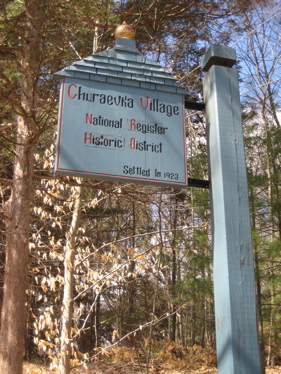
I asked a random woman what the occasion was and she somewhat quizzically told me it was a “real” Russian Orthodox service; something that only happens here once or twice a year. And, on top of that, the priest (I’m guessing they are priests in this religion) was from New York and it was a big deal to have him up here. “Oh, okay, that’s great thanks,” I said, sort of bummed I wouldn’t be getting any pictures of the chapel.
“Why don’t you join us,” she said with a mild Russian accent. Ummmm, no thanks. I don’t speak Russian, I don’t follow your religion, I’m dressed like a bum, I’m late, and I have a five year old with special needs sleeping in the back seat.
“Leave him in the car and come down. You can take pictures,” she said and walked on. I thought about it… Damian had woken up and had a game to play with and I DID really want some pictures and what’s more, the chapel was OPEN; and it’s pretty much never open. (Actually, I think the same friendly woman does open it up on nice Saturdays once in a while in the summer.) So I made the move.
Some guy started talking Russian to me and I smiled and told him I had no idea what he was saying. So then he smiled and said, “Orthodox?” I smiled back and said no, no, I’m just a guy driving by who was invited down by that nice lady over ther – phew, she was coming to rescue me. Which is exactly what she did and allowed me to poke around and ask a few questions and display my abject ignorance about Russian Orthodox WhateverReligionItIs.
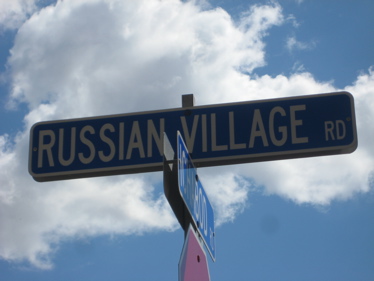
She was super nice and invited me over and over to join the worshippers at the table for some feasting. I totally would have too, if not for Damian back in the car. Oh yeah… Damian. So while I tend to him, here is all you’ll ever want to know about Russian Village in Southbury. Rather amazing who has lived here over the years… Definitely one of Connecticut’s cool little unknown stories.
The first bit is from the wonderful Historic Markers Database site:
Formerly known as “Churaevka,” Russian Village was established in 1925 as an artistic community for Russians who fled to America after the Revolution of 1917. The village was created by two Russian writers, Count Ilya Tolstoy, the son of Leo Tolstoy, and the famous Siberian novelist George Grebenstchikoff.
Although Tolstoy was first to discover the area while visiting his translator in Southbury, it was Grebenstchikoff who dreamed of establishing a cultural center and actively planned to create a rural haven where Russian writers, artists, musicians and scientists could live and flourish.
Some other better known names connected with Churaevka are Igor Sikorsky, helicopter inventor; Sergei Rachmaninoff, composer; Michael Chekhov, actor; Baron Leo von Nolde, writer; Nicholas Roerich, philosopher and painter; and many other prominent figures in the world of art, literature and music.
The village was named after a mythical Siberian village mentioned in the works of Grebenstchikoff.

[CTMQ Note: In the second article below, Churaevka is said to be named after Grebenstchikoff’s real hometown in Siberia.]
Churaevka Village is still the name that appears on all property deeds. In later years it has come to be referred to as “Russian Village.”
The main building in the village is the chapel which was designed by Nicholas Roerich. Commissioned by George Grebenstchikoff and financed with generous contributions by Igor Sikorsky, it was built in 1932 – 33 with labor volunteered by village residents, including a skilled stone mason named Ivan Wassileff. The chapel is dedicated to one of the most venerated saints of Russia, St. Sergius, who kept Christianity alive after the Tartan invasion of the 14th century. It is also meant to be a memorial to the Cathedral of Our Savior which was destroyed by the Soviets in 1931.
An important feature of the village was the Alatas Print Shop. The print shop acted as a publishing house to foster the dissemination of Russian culture. Grebenstchikoff used the Alatas Print Shop to publish the works of several Russian authors, as well as his own books. The building still stands, but is no longer in use.
That was a good start. Another, much more thorough article about the place can be found here. I’m just going to pull out the random stuff I found most interesting and encourage you to read the whole thing on your own. (Believe it or not, this is only a bit of the original.)
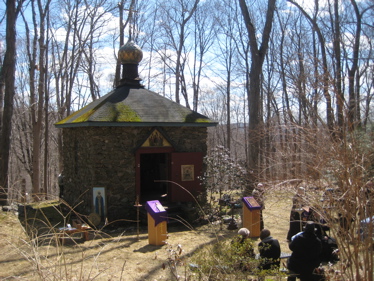
Most of the original cottages, except for an American Foursquare built in 1928, are vernacular buildings of no particular architectural style built between 1923 and the late 1930s. They do, however, share some common characteristics which are an interesting combination of American stylistic features and subtle influences introduced by their Russian owner/builders, such as steeply pitched roofs, dormers, and door hoods.
Some of the best-preserved, unaltered examples of these cottages are the Somoff Cottage, one of few shingled versions, the Tolstoy Cottage, and the Wassil Cottage. .
The centerpiece of the village is the St. Sergius Chapel, a rubblestone building square in plan (14’x14′) with a hipped roof surmounted by a gilded onion dome with a double Russian Orthodox cross. The wide entrance door is elaborated by a pediment with a polychrome fresco. The interior, which contains the altar, has scrolled designs painted around the openings to the three narrow windows, one in each of the other stuccoed walls. Since the chapel is too small to contain the congregation, a small amphitheater with curved stone benches faces the facade elevation. On the west side of the chapel grounds is an unusual stone and cement statue which has commemorative symbolic meaning for the village.
The statue is a visible symbol of not only the special cultural heritage that produced Churaevka but also the determination to keep the village intact. Sviatogor was the most famous of a series of legendary giants in Russia from the tenth to the twelfth century who defended Mother Russia from the invading barbarian hordes. Purported to be 7’7″ tall and weighing almost 300 pounds, he served the Court of Prince Vladimir in Kiev. The prince was responsible for establishing Christianity in Russia in 988 by recognizing the Eastern Catholic religion, later known as the Russian Orthodox Church. The millennium of this event will be celebrated in Churaevka in 1988.
…
Russian Village, or Churaevka, as it is known to its inhabitants, was established as a summer retreat for Russian refugees who fled from Russia after the Bolshevik Revolution of 1917. Not simply an ethnic neighborhood transplanted to a country setting, the village was created by two Russian writers. Count Ilya Tolstoy and George Grebenstchikoff. Although Tolstoy was the first to discover the area when he was visiting a translator for one of his books in Southbury, it was Grebenstchikoff who dreamed of establishing a seasonal cultural center and actively planned to create a rural haven where Russian writers and artists could live and flourish.
Both men were attracted by the natural beauty of the Connecticut hills, which reminded them of the Russian countryside. The small dacha (vacation home) that Tolstoy built in 1923 is still standing, one of the few properties in the Russian Village Historic District that has not been remodelled for year-round use. He likened the setting for his cottage to his family’s estate near Tula, about 130 miles from Moscow, known as Yasnaya Polyana (literally clear meadow). The stands of birches on Horse Fence Hill, as it was first known in Southbury, were also a familiar sight to the first settlers, but these are no longer standing, having given way to other deciduous trees, as well as mature evergreens which were planted by the community more than 50 years ago.
George Grebenstchikoff, the son of a Russian peasant, was born in Churaev, Siberia. From 1925, when he came to Southbury, until his death in 1957, he used his talents as a writer to promote Churaevka, named for his birthplace. In one of his books, published in Italy in 1935, he described the area and his ongoing dream for its future. The book, II Meso: Lettere Dal Pomerag, literally letters from the Pomeraug, is liberally illustrated with photographs which capture his romantic vision of himself as a new pioneer in the Connecticut wilderness.
Underlying this romantic metaphor, however, was the enthusiasm of a zealot combined with a surprising degree of pragmatism. He purchased most of Tolstoy’s holdings in 1925. The following year he added another 100 acres to the village, purchased from a local landowner, and had begun to articulate his visionary concept for Churaevka. In an extensive interview in the Bridgeport Post, July 7, 1928, he described his threefold mission for the colony. It can be summarized as follows: In addition to his basic concept of a harmonious cultural center “conducive to creative development,” he envisioned the colony as a “practical school of life.” His final goal for the village was far grander in scope. Churaevka was to be an active center for the dissemination of the knowledge of Russian life (presumably that of pre-revolutionary Russia) and a force for peace in the world. He believed that a free exchange of ideas and material goods between the United States and Siberian Russia would lead to a spiritual and peaceful cooperation. By 1927 he had already sold some of his lots and drawn up his development plan for the community, reserving open space in a manner that anticipated modern suburban planning by many decades. Except for the fact that it never had as many settlers as Grebenstchikoff had anticipated, the village today essentially conforms to his original plan.
…
Frequent guests in the village in the 1930s included distinguished Russian contributors to art, dance, music, and the theater: Grebenstchikoff’s patron, the artist, Nicholas Roerich; the pianist and composer, Sergei Rachmaninoff; the actor Michael Chekhov, also a producer of his uncle Anton Chekhov’s plays; and Vera and Michael Fokine, both ballet dancers. As a choreographer, Michael Fokine is credited with the development of modern ballet. Igor Sikorsky, who remained a lifelong friend and supporter of Grebenstchikoff, often visited with his family. He purchased land in the village but never built a cottage there.
…Churaevka was once again a safe haven after World War II, but it was a turbulent period for the village, particularly during the Cold War. It is clear from the few surviving records that the 1950s were a difficult time for the residents of the Russian Village Historic District, the era when Russian was synonymous with Communist in the American mind-set, a gross misunderstanding of the background of the community. The villagers felt called upon to defend their patriotism and their commitment to the local community of Southbury. For the first time they referred to themselves as “Russian-Americans,” calling the first organization in the community the Russian-American Village Improvement Association.
Wow. That was a lot. And like I said, there’s plenty more here.
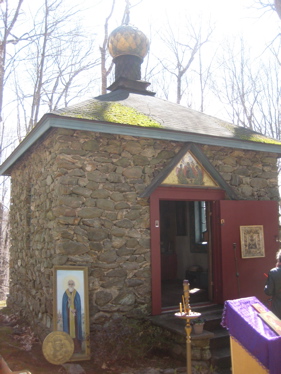
Houses, Communities, Libraries & Businesses

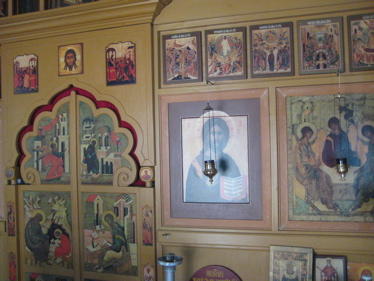
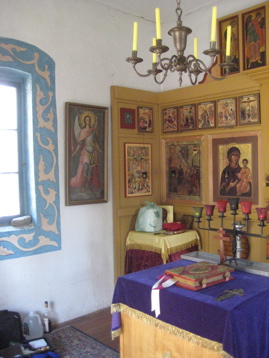
 Rob says
Rob says
May 12, 2011 at 7:45 amNifty! It’s always kind of crazy the number of famous people that have lived in the state and that no really knows about, except locally. Countess Tolstoy lived in Haddam next door to the CCC camp. Apparently she’d occasionaly invite the C’s over for tea. Wrap your mind around that scene!
 Cathryn B. says
Cathryn B. says
July 18, 2012 at 7:15 pmHello, here is an interesting tidbit regarding this area. When I was a teenager, I used to stay with my friend and her family at their summer home on the Pomperaug River. Their house was directly across the river from the Russian Village (which I just learned today.) This was in the summer of 1981,82 or 83. One day, her dad and older brother went exploring on the other side of the river (very steep uphill and all trees). They were stopped by a man with a foreign accent and … a large hunting rifle! The man would not talk with them, only told them “Go away” and actually pointed the gun at them! He must have been a resident of the Russian Village area on the top of the hill. I am going to share this info about the Village with my friend. What would we do without the Internet! ha ha Also we would swim to the other side of the river where there was an awesome rope-swing tied to a tall tree. Nobody ever bothered us kids about using that, though.
 Miriam S. says
Miriam S. says
February 1, 2013 at 2:55 pmHi,
Wondering if there are any written diaries of some of the founders going back 1910-1917 period (shortly before they started the Village) that might be available to read?
 George V. says
George V. says
December 15, 2013 at 11:59 amRemembering Churaevka:
When I was a kid in the late 1930s, I spent summers in Churaevka, knew everyone living there, and staying at the house of Ivan Ivanovich Ushakoff (a former Don Cossack and member of the Duma), and Ivan Vasilievich Vasilieff (Wassil) whose wife, Thaissa, was a special pal. Ushakoff was one of the very first settlers there (c.1922?) who had cleared his land with an Ox team. He built his 2-story house on the top of a steep hill with access to the river below by a long zig-zag trail through a wooded forest, where he kept his boat, outboard motor, and tackle. He had built a small deep cement pool some distance down the trail which he used as an aquarium.
He kept a large number of hard-bound copybooks where he had written about all his life experiences, going back to stories his great-grandfather had related dating to the Napoleonic period! It was an occasion when he would relate his tales to friends on his porch, accompanied by tea from his samovar. He introduced me to fishing for Calico Bass in the Housatonic River, of which the Pomperaug River is a tributary. On evenings we used to sit on the porch and watch the flying squirrels glide downhill from their cozy home in his attic. Ushakoff and his wife were loved by one and all. His notebooks must be located for they are a historical treasure trove. I hope they have survived the rigors of time.
Somoff was Rachmaninoff’s secretary and manager, while his wife (a charming lady) was my father’s cousin. They had a particularly picturesque house and covered well, and took care of the Pomperaug river down below their property. It was most picturesque and natural.
I had explored every trail up the Pomperaug River and knew just about every resident there. In the 1970s I discovered to my dismay that the Pomperaug had been polluted some miles upstream, resulting in the near extinction of fish – a tragic event, especially so because that had been a pristine river with a very diverse and delicate ecology.
I would welcome correspondence on the subject of Churaevka.
regards,
George
gvitt -at- dslextreme.com
 Sandi Heigelmann says
Sandi Heigelmann says
January 26, 2014 at 9:42 amI remember visiting my Aunt Helen when I was a little girl. To me the village seemed like a place that had little dollhouses everywhere. I was around 5 or 6 when I visited there. It was in the early 70,s. I love going to visit there. However, I can’t seem to remember her last name. I think it was Sahalsky. That was my grand mother’s last name. Anyone that could help me out with any information regarding my Aunt Helen,please feel free to email me @ sheigelmann13@ gmail.com.
Thank- You!
 Sandi says
Sandi says
March 6, 2021 at 1:06 pmRemembering my Aunt & Uncle’s last name. Basil and Helen Niccolocheff if anyone was curious.
 Robin says
Robin says
December 18, 2021 at 4:43 pmI had the great good fortune to live in Russian Village from the mid to late 1990’s until March 2013. My then husband and I, along with our two children, took one look of the beginning of the Village and knew we were home. We entered the absolutely charming house that we were there to look at, walked into the sunny and very large dining and living area and knew that we were most definitely home. My husband left a few years later, but the kids and I stayed. The school system was outstanding and I made sure we were able to stay until my youngest had graduated from High School.
Sadly, while Connecticut Magazine had once declared it the best small town in Connecticut, the town became overrun with
MacMansions, the Pumpkin Patch became a shopping plaza, etc, it was not, although with great shopping among other things, the place we were, first drawn to. My “fixer upper “ had become an overwhelmingly “Oh, God please help me!” and it was time to go.
I think of it still, miss it so, but am forever grateful for the great good fortune to live in such a beautiful place with even more beautiful people .
 E Keating says
E Keating says
March 6, 2023 at 6:43 amI live in Southbury, visited the Village several times. One services were being held at the little chapel. Was told that services were held once a year on a Russian Saints Day. Can’t remember the Saints name. Are servers still held there. .